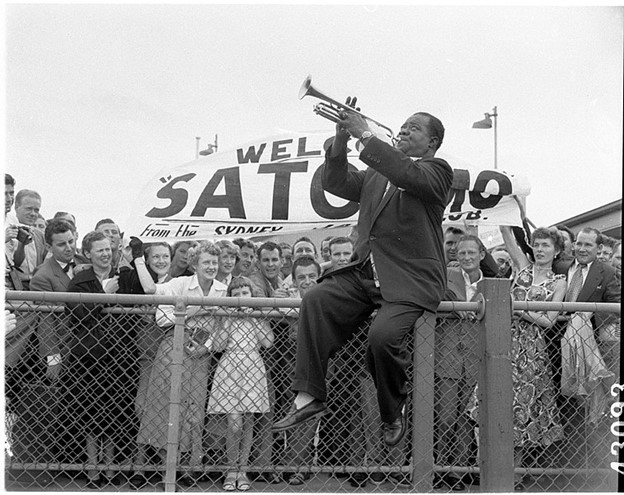This image pictures Louis Armstrong playing a trumpet in from of a large group of people in Mascot, Sydney((Louis “Satchmo” Armstrong Plays for Fans on Arrival at Mascot, Sydney, 27 October 1954. https://commons.wikimedia.org/wiki/File:Louis_%22Satchmo)). Louis Armstrong was an African American musician who helped create what is known as jazz music. Jazz combined ragtime with the emotions of blues music((Emory, Shi. America: A Narrative History. W.W. Norton and Company, 2021.)).
Armstrong was known for his unique “froggy voice” he was innovative and reshaped the music of the time((Ibid.)). Armstrong was born in New Orleans and had a rough childhood. He was abandoned by his father and left to be raised by his mother who was a prostitute((Ibid.)). Armstrong discovered music by watching early jazz innovators while he was a teenager((Ibid.)). By the late 1920s, he became one of the most popular musicians in the nation. His energy is what made him so popular. Armstrong radiated joy and his work was powerful enough to bring about racial harmony((Ibid.)). Armstrong has a natural enthusiasm and warmth and was known to undermine many racial stereotypes((Miller, Mark ed. Louis Armstrong: A Cultural Legacy. New York: Queens Museum of Art/Seattle: U of Washington P, 1994. 248 pp.)). Jazz was an outlet and a way to shed light on this time period in American history for people of African descent((Joachim, Joana. “Black Gold: A Black Feminist Art History of 1920s Montréal.” Canadian Journal of History, vol. 56, no. 3, 2021, pp. 266–291)).
Looking at the image above, it can be seen that the people went above and beyond to welcome Louis Armstrong with open arms; they even created a poster that reads “Welcome Satchmo”. Satchmo was a nickname that was given Armstrong, it was actually short for “saddle mouth” because of the large shape of his mouth((Ibid.)). This was not an offensive nickname it was seen as endearing, along with his other nicknames: “Satch” and “Pops”.
The 1920s is when his rise to fame began. There were many people who imitated his style and soon Armstrong was seen as a star attraction. The 1950s is when Louis Armstrong was recognized for his remarkable skills as a singer and his voice was recognized internationally. He recorded one of the most popular duets of the 1950s called “Porgy and Bess” with Ella Fitzgerald((Ibid)). However, as his fame was increasing, people of color felt that Armstrong was not upholding the responsibilities for the Black community at the time of the civil rights movement((Cofresi, Diana. “Louis Armstrong Biography.” PBS, Public Broadcasting Service, 9 Aug. 2022, https://www.pbs.org/wnet/americanmasters/louis-armstrong-about-louis-armstrong/528/.)). People saw him as an “uncle tom” who traveled and played for mainly white audiences worldwide and that can be seen in the image above where Armstrong is playing in Mascot, Sydney((Ibid.)).
Louis Armstrong performed worldwide with his All-Stars and they began a tour in Europe. He grew in popularity and during the Cold War, he was a well-known and loved artist by both civilians and soldiers. In Berlin, he was welcomed on both sides of the wall. Arvell Shaw, another jazz musician at the time stated, “No boundary was closed to Louis” ((Jones, Josh. “Louis Armstrong Plays Historic Cold War Concerts in East Berlin & Budapest (1965).” Open Culture, https://www.openculture.com/2014/03/louis-armstrong-plays-historic-cold-war-concerts-in-east-berlin-budapest-1965.html.)).
Although Armstrong became a world-renowned star, there was some controversy involving his tours. He faced backlash because of his decision, while in Berlin, to not engage in conversation about race problems in the United States. When he was in the South, he was vocal about the issues that went on there and how unjust the people of color were treated. Then when he got to Europe, he did not make a point to bring these social injustices to light instead he steered clear of any social issues that came up in conversation and even went on to say, “I have been treated fine in the South”. When he rose to fame, his roots were planted in the past and he had little regard for people like himself who were struggling back at home. Even though people expressed these concerns and ideas, Armstrong still spent the next years traveling and performing around the world ((Jones, Josh. “Louis Armstrong Plays Historic Cold War Concerts in East Berlin & Budapest (1965).” Open Culture, https://www.openculture.com/2014/03/louis-armstrong-plays-historic-cold-war-concerts-in-east-berlin-budapest-1965.html.)).
Armstrong was seen as a symbol of jazz music because of his profound influence on the genre of music. He also symbolizes the culture of 20th-century America because of his heartfelt performances that helped shape that time period and his legacy is still carried on.
